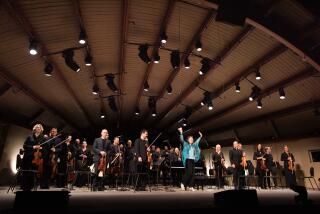Sibelius’ Return to Favor
- Share via
After decades of neglect, the music of Jean Sibelius is again in favor in this country and Western Europe, thanks in no small part to its championing by such leading conductors of the younger generation as Simon Rattle and Esa-Pekka Salonen.
And while the composer may never have been out of style in his native Finland, there has been a shift in the center of Sibelian gravity there, away from Helsinki, which has always had the putative major orchestras. Today, the best of Sibelius is more likely to be found some 50 miles to the north of the capital, in the industrial town of Lahti, population about 100,000. It’s the home of the Lahti Symphony--just imagine an American city of that size having a full-time orchestra or an audience to justify its existence--and its energetic conductor, 43-year-old Osmo Vanska.
All of this activity is reflected in, and encouraged by, the decision of BIS, the Swedish recording company, to entrust the orchestral portion of its complete edition of the composer’s works to the Lahti forces.
The partnership is producing world premiere recordings, tracing Sibelius’ development, not only from the early stages of his career in the 1890s, but in terms of his progress within a work, that is, with the original versions of works later revised to achieve their familiar shapes.
The first recording of the Fifth Symphony (BIS 800) in its original 1915 edition is an ear-opener. It’s much longer than the 1919 version; more discursive, less varied harmonically, darker in its orchestration and more dissonant--closer to the Fourth Symphony, which supposedly has no kin in the Sibelius canon. Well, here’s proof that it does, in a sprawling, thematically prodigious (many of the themes are trial balloons, quickly discarded) four movements, as distinct from the architecturally taut, three-movement final form.
The composer’s later thoughts unquestionably resulted in a more cohesive and dramatic work. But there’s interest here too, despite the lack of some of the familiar elements of version two, such as the opening horn call, the famous little trumpet tune in movement one, and the six tense chords with which the symphony as we know it concludes.
The coupling is instructive too: the first version (1892) of the tone-poem “En Saga,” gloriously evocative, in either version, of impenetrable forests, seductive sprites and ill-fated heroes on horseback--the whole Nordic enchilada.
I must confess to finding the longer draft a viable alternative, perhaps even superior, to the published product of a decade later. Version one projects a morosely Russian spirit that is less obvious in its successor, with orchestration weighted toward the low brass, and some rather terrific drumming, while the memorable themes of the ultimate edition are already in place. Still, there’s no denying that the version we’ve known until now is leaner and shorter, if not meaner.
Late last year, The Times reported on the unearthing of a substantial orchestral work from the 1890s, “The Wood-Nymph,” and its first public hearing within memory, performed by the Lahti orchestra, was treated by the Finnish press as a sort of musical second coming. The recording, from sessions that took place immediately thereafter, has just arrived (BIS 815).
If “The Wood-Nymph” doesn’t rank near the top of the Sibelian heap, it’s still lovely, offering a compelling glimpse into Sibelius’ early method and at certain characteristics he retained through his creative lifetime. Its moodiness should appeal to seasoned Sibelians, as will its powerful sonorities. There are also small felicities found only occasionally elsewhere in Sibelius’ output, such as a bit of Orientalia (recalling the delicious “Belshazzar’s Feast” score) and a cello solo at once suggesting Slavic pathos and Gallic elegance.
The companion works include the attractive complete incidental music--previously recorded only in suite form--to the Strindberg play “Swanwhite.”
In all instances, the performances by the Lahti Symphony under Vanska are not only obvious labors of love but highly accomplished, with never a hint of being rushed into production, as many world premiere recordings tend to be.
More to Read
The biggest entertainment stories
Get our big stories about Hollywood, film, television, music, arts, culture and more right in your inbox as soon as they publish.
You may occasionally receive promotional content from the Los Angeles Times.










